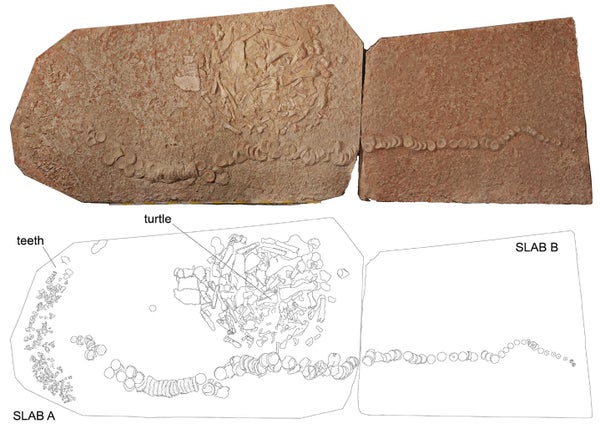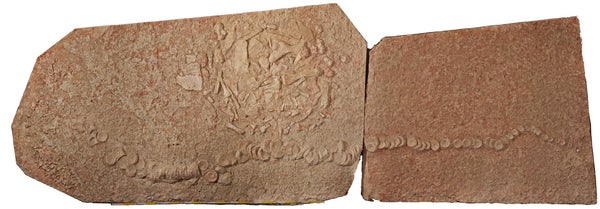This article was published in Scientific American’s former blog network and reflects the views of the author, not necessarily those of Scientific American
On supporting science journalism
If you're enjoying this article, consider supporting our award-winning journalism by subscribing. By purchasing a subscription you are helping to ensure the future of impactful stories about the discoveries and ideas shaping our world today.
Finding any fossil is a happy occasion. Given that only a fraction of a fraction of a fraction of all the Earth’s organisms even had a chance of entering the fossil record, even a scrap of prehistoric life is a wondrous thing. Even better are bonus fossils. Find one petrified organism and it might be joined be another juxtaposed with it, and among the most amazing are fossils within fossils. Take, for example, an unlucky turtle found mashed up inside a Cretaceous shark.
Sometime in the 1990s, paleontologist Jacopo Amalfitano and colleagues report, a lovely shark fossil was found in the Venetian Prealps of northeastern Italy. It’s the most complete of its kind ever found. Assigned to the genus Cretodus by Amalfitano and coauthors, the shark is the first occurrence of its kind in Italy and consists of 120 teeth, 86 vertebrae, and a handful of scales.

The two slabs and a diagram to the pieces. Credit: Amalfitano et al. 2017
Not everything is in place as it was. Some of the teeth and vertebrae fell out soon after discovery and were glued back into place with those that remained on the slabs. Still, this fossil remains the most complete Cretodus yet known, a rare look at a fish that grew to the size of a modern great white shark. The fact that teeth, vertebrae, and scales were all found together means that paleontologists can now be more confident about identifications of Cretodus parts when found in isolation.
But even better is what was preserved with the shark. Or rather, within. Midway along the vertebratal column, nestled just beside it, is a round pile of bones. This is a prehistoric turtle. Now, there are all sorts of ways that two different fossils can be buried together. The same phenomena that bury bodies often transport them, creating associations in death that never happened in life. But the location of the turtle and a few fossil clues indicate that shark and turtle really did meet in life, albeit briefly. This turtle was the shark’s last meal.
This turtle did not just wash in. Its skeleton is totally disarticulated, Amalfitano and colleagues write, tightly packed into a bolus of bone. Even taking out pieces that fell off the slab and were glued back into the ball, it’s still a wad of prehistoric turtle bone. The species of the turtle isn’t known yet – it’s a hell of a jigsaw puzzle – but initial investigations turned up some additional evidence that the chelonian was eaten by the shark. The turtle bones are right where the shark’s stomach would have been, some of them appear to have been bitten, and there’s a Cretodus tooth mixed in with the turtle bones, which, like the turtle remains, looks to have been etched by digestive acid.
“A large Cretaceous shark feeding on a marine turtle is not unexpected,” Amalfitano and coauthors write. After all, today’s bull, tiger, lemon, and great white sharks have all been reported to snack on the hard-shelled reptiles. But to find such a fossil, binding two ancient species together, is something that can never be predicted even when it’s hoped for. It’s now a bridge between the hazy past and the present, tying shark and turtle together through the depths of time.
Reference:
Amalfitano, J., Dall Vecchia, F., Giusberti, L., Fornaciari, E., Luciani, V., Roghi, G. 2017. Direct evidence of trophic interaction between a large lamniform shark, Cretodus sp., and a marine turtle from the Cretaceous of northeastern Italy. Palaeogeography, Palaeoclimatology, Palaeoecology. doi: 10.1016/j.palaeo.2016.12.044
